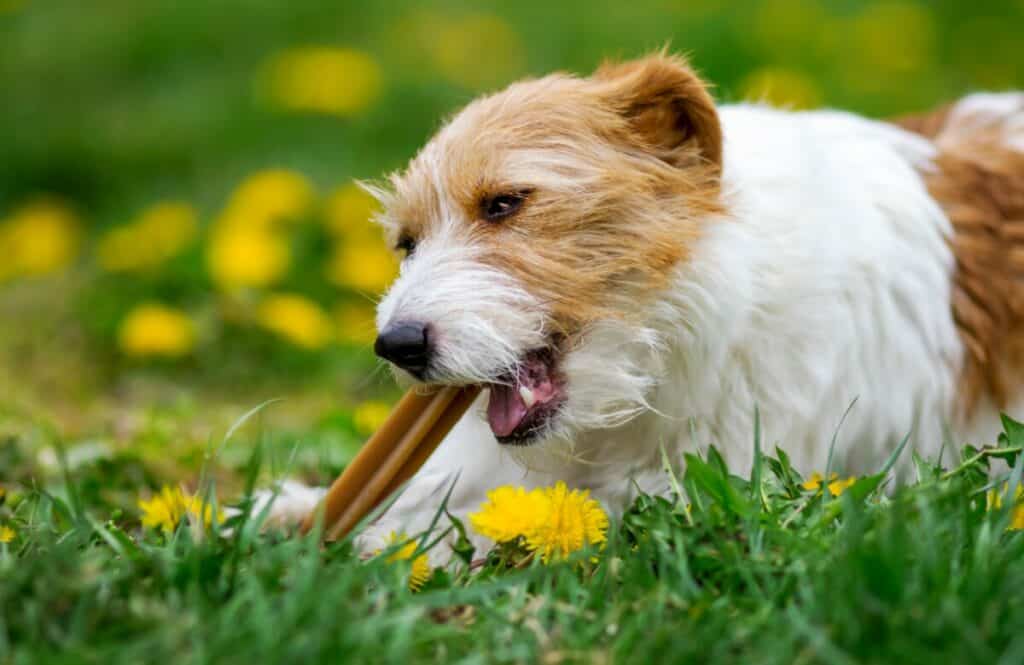
Many dogs enjoy chewing on bully sticks, but how long should puppies be allowed to chew on bully sticks?
Puppies can chew on bully sticks safely until the stick is short enough to become a choking hazard. Owners should purchase bully sticks in sizes appropriate for their puppy since puppies can upset their stomachs by eating too much, but the sticks are safe for puppies to consume.
To find out more about puppies and bully sticks, keep reading.
How Long Can a Puppy Safely Chew a Bully Stick?
A puppy can safely chew on a bully stick until the stick is consumed, the chewing session is done, or until the stick is short enough to become a choking hazard.
Unlike rawhide or other chemically treated chew treats, bully sticks are dried beef muscle. Also known as pizzle sticks, “bully sticks” is just a more appealing name for a dried bull phallus. They are nutritious, great for puppy dental hygiene, and don't contain harmful ingredients.
Don't leave your puppy alone while they're chewing the stick, and stay alert to these situations where the puppy should stop chewing on it.
Caloric Content
One of the primary concerns for puppies chewing treats is the caloric content the puppy is consuming. While puppies do need plenty of food to grow, they are still at risk of becoming overweight. Any treats outside of nutritionally balanced puppy food should be limited.
There are charts available online to help you find the appropriate size of bully stick for your puppy. Be aware of choking risks if you get a smaller stick for a larger puppy.
Remember that your puppy doesn't need to finish the bully stick in one sitting. If they walk away from the stick, or if you choose to take the stick, they can resume chewing at a later time.
Puppy Energy Levels
Puppies love to chew, but it can tire them out. Puppies who are learning to chew on bully sticks as part of early enrichment should only chew until they need a break for another activity, like potty training. Just like with human kids, you should make sure they have enough energy to eat their dinner after playing.

Choking Hazards
Both puppies and older dogs are at risk of choking on chew treats that are too short. Once the treat gets down to one or two inches long, you should remove the treat or keep a close eye on your dog as they chew it.
Dogs and puppies should never be left unsupervised when chewing on a treat or a toy. Small pieces can break off of bully sticks and similar items, and dogs that are focused on snacking are vulnerable to inhaling them.
Chewing aids like Bully Buddies can help dogs stay safe. These chew treat holders help dogs hold the treat still while they finish it, giving them a little more control and preventing them from inhalingthe end before you can stop them.
How Often Should a Puppy Chew on a Bully Stick?
While bully sticks are great for your puppy's dental health, they should remain a treat, not a diet staple. Puppies need their calories to come from sources of balanced nutrition like puppy food, and consuming bully sticks can fill their stomachs without giving them the nutrients they need to thrive.
The exception to this rule is if you're removing the bully stick before it is completely consumed. If the puppy is only chewing the stick for a while, not finishing it, it isn't getting all those unbalanced calories in its diet.
A puppy can have about two to three bully sticks a week. You can choose whether to let the puppy finish a stick in one sitting, or whether you'd rather break it up into multiple chewing sessions.
Can I Give My Puppy a Bully Stick Every Day?
You should not give your puppy an entire bully stick every day, since that would unbalance their diets and they wouldn't get all the nutrients they need from their puppy chow.
However, you can stop their chewing session before they finish the stick. They can finish it the next day.
Letting your puppy chew a bully stick every day offers a few benefits.
First, it gives the puppy something to chew on besides furniture or shoes, teaching good habits. Puppies need to chew, and this is an appropriate outlet for that behavior.
Second, it helps their dental hygiene by removing the biofilm that turns into plaque. Chewing treats like Bully Sticks is a natural way to keep your puppy's teeth clean.
Third, bully sticks are pure beef protein. While they shouldn't be a core part of your puppy's balanced diet, they're much healthier than many other treat options. A little extra protein helps dogs keep strong muscles, nails, and coats.
Are Bully Sticks Better Than Rawhide or Bones?

Bully sticks are better for dogs, including puppies, than other options like rawhide and bones. They're safer, more nutritious, and just as easy for owners to access.
Bully Sticks are More Nutritious
Rawhide and bones from the store are fairly nutritionally null for dogs, including puppies. They've been soaked and cleaned until there's nothing nutritionally beneficial left.
Bones from a butcher are more nutritious than pet store bones, but few owners want to deal with how messy they can be.
Bully sticks, which are pure dried beef protein with just one ingredient, are more nutritious than other options.
Bully Stick are Safer Than Rawhide or Bones
The biggest problem with rawhide chew treats is that dogs can break off chunks large enough to be choking hazards. Dogs of any age or size are vulnerable to this, particularly puppies. Bully sticks don't have this issue because they're less brittle, and they're more likely to soften and tear off in small bits instead of large chunks.
Bones have a more complicated and equally dangerous problem. Bones can splinter, which means that dogs swallowing the splinters can end up puncturing internal organs. Cooked and raw bones both present this issue.
Bully sticks, which are pure and uncut muscle and tissue, don't splinter like bones and don't tear like rawhide. You can let your puppy chew on them with confidence.

Cindy is a prolific writer and online researcher who can't imagine life without dogs. There is scarcely a dog topic she has not researched or written about. Her love for dogs and helping dog parents is evident by the thousands of dogtemperament.com visitors who read her articles monthly. Most of all, each topic Cindy writes on helps forge a stronger bond and understanding between her and her happy Catahoula Leopard Dog Jossie.